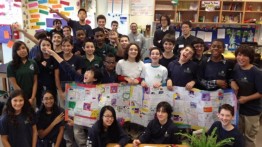Engineering Sustainability with Queens Middle School Students
POSTED ON: March 19, 2012
While many Cooper Union students were eagerly heading out of town on Friday, March 9 for a well-deserved vacation, 17 engineering students were on their way to Jamaica, Queens for an alternative spring break. They visited the Metropolitan Expeditionary Learning School (or MELS) to help seventh graders build fuel cell model cars while applying principles of automotive engineering and efficient transportation. MELS is a sustainability-focused school that immerses its students in collaborative relationships with college and industry experts. The students’ learning of science, technology, engineering, and math is enhanced through hands-on expeditions in New York, whereby the city turns into their laboratory.
In its second year, this outreach program was led by students from the Formula SAE Team (Cooper’s racecar club) and Cooper Union’s chapter of Pi Tau Sigma (the Mechanical Engineering Honor Society). Organized by mechanical engineering professor George Delagrammatikas, and teachers Abigail Sewall and Jenna-Lyn Zaino from MELS, this collaboration offered a chance for the seventh grade class to visit Cooper Union and learn about energy efficiency and alternative fuels during winter break. In March, Cooper Unions students repaid the visit by traveling to MELS and leading a workshop with students there constructing fuel cell powered model cars.
The model cars constructed by MELS students were assembled from kits that were donated through a joint initiative between the John Deere Corporation, the Society of Automotive Engineers, and A World in Motion. These kits were developed to help budding engineers learn about the complex packaging and technical applications involved in automotive engineering in general, and in particular on how to produce mechanical power from basic hydrogen and oxygen—the constituent elements of water
“It was really impressive to see how much the middle school kids knew about the internal combustion engine and how to make an efficient car,” says mechanical engineering senior Muneeb Hai who was among the Cooper Unions students to visit MELS. “Putting the cars together was a good introduction to the practical aspects of engineering—we got to help the kids with the same sort of packaging and assembly issues we deal with building the Formula SAE car, albeit on a much smaller scale.”
The experience of constructing the cars helped demystify how a complex system like an engine puts chemical and mechanical engineering principles into practical application, realized in a model-scale, self-powered automobile. “Engineering is a mix of things you learn in your classes and things you learn doing projects,” adds Hai, “and the MELS students got a good taste of that.”






